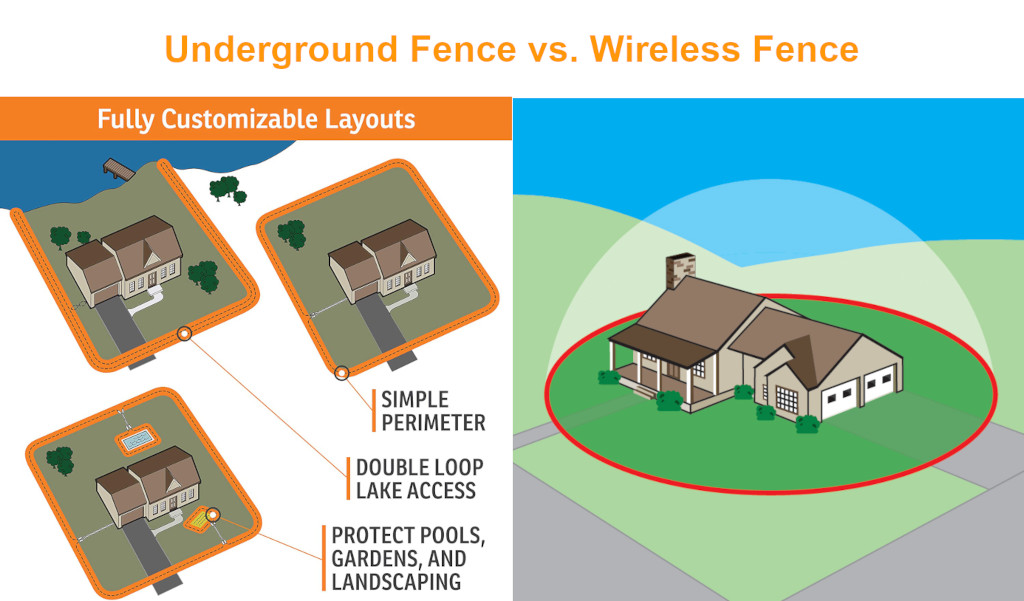
You’ve been shopping around for the best way to keep your furry friend safe and contained, and the neighborhood you live in has no-fence law, or the Homeowner Association (HOA) won’t allow you to put up a fence that can keep your Houdini hound from escaping. Or you simply don’t want an unsightly fence marrying your beautiful landscaping.
You’ve considered all your options, and after much research, you’ve narrowed it down to two options, a wired underground dog fence or a wireless dog fence. And you’re now stuck trying to decide which one is better.
Fret not! We’ve got you covered.
In this blog post, we’ll look at the differences between wired underground dog fences and wireless dog fences, as well as the pros and cons of each, to help you decide which one is right for you.
The Differences Between an In-Ground Dog Fence & a Wireless Dog Fence
We’ve been getting asked a lot lately about the differences between an in-ground dog fence and a wireless dog fence, and is an invisible fence a different type of containment system? Well, it’s easy to see why many people are confused.
But let’s just start by clarifying what each type of system is.
An underground dog fence, also known as an in-ground dog or a wired dog fence, is a containment system that uses buried wires to create an invisible boundary around your property. It has a base station or transmitter that sends radio signals to the wires. When your dog approaches the boundary, they will receive a warning beep from the receiver collar they are wearing, letting them know they are getting close to the boundary. If they continue moving past the buried line, they will receive a static correction.
On the other hand, a wire-free or wireless dog fence is a fencing system that uses a central transmitter to create a circular containment area. It does not use wires, making it much easier to set up. The transmitter will communicate directly with the receiver collar your dog wears, and the way it works is much like an underground fence, in which your canine will receive a warning signal when they wander too close to the circular boundary the transmitter creates. If they continue to move past it, they will get a mild electric shock.
How about an invisible fence?
Well. It’s just another terminology for wireless fences and wired underground fences for dogs. The best way to think of it is that once both systems are installed, there are no visible barriers like picket fences or chain-link fences, basically making them invisible to the eyes, hence the term “invisible fence.”
In-Ground Dog Fences vs. Wireless Dog Fences - Which One Should You Choose?
So, which system is better, an underground dog fence or a wireless dog fence, and more importantly, which one should you choose?
Unfortunately, there is no simple answer because it depends on your unique situation. For instance, your budget, the size and layout of your yard, whether you’re looking for a more permanent setup or a portable system, and how much work you’re willing to put into the installation process.
We’ll break it down a bit further to help you decide which type of fence is right for you.
1) Reliability: Underground Invisible Fence for Dogs ✅ vs. Wireless Dog Fence ❌
Reliability is perhaps the most crucial factor to consider. Because, after all, what’s the point of spending money on a containment system that doesn’t work?
And if we were to compare the two systems in terms of reliability, in-ground dog fences are the clear winner.
This is because, with a wireless fence, the signal travels through the air, meaning it can be obstructed by things like trees, shrubs, buildings, large metallic objects, and even bad weather. If disrupted, it can cause the signal to be weaker in certain areas of your yard, which can give your dog just enough leeway to escape.
One more thing that will affect a wireless fence’s reliability is if your property is on sloped land. The signal will be weaker on downward slopes due to the distance it has to travel, resulting in “weak spots” where your dog can potentially get out.
That’s not to say that wireless dog fences are completely unreliable. A wire-free fence will work just fine if you have a flat landscape and there aren’t too many obstacles interfering with the signal.
On the other hand, underground fences won’t be affected by any of the interference mentioned above because the signal is carried through the wires buried underground. As long as it is installed correctly and the wire is not damaged, you can rest assured that the boundary will be as reliable as it can be throughout your yard.

2) Customizability: Underground Electric Dog Fence ✅ vs. Wireless Pet Containment System ❌
Underground fences for dogs are again the winner when it comes to customizability.
With an in-ground system, you can customize the shape and size of your containment area however you want. You can make it as big or as small as you need, and you can even create odd shapes if necessary, which is especially useful if you have an irregularly-shaped yard.
Another thing that makes underground fences stand out in terms of customizability is that they offer the option to create multiple zones. This means you can have one zone for your front yard, one for your backyard, and so on. This can come in handy if you want to keep your canine out of certain areas of your property, for instance, a garden or swimming pool, or if you need to confine them to a specific area.
Wireless fences, in contrast, are limited in this regard. They only create a circular containment area. And yes, you can adjust the radius of the circle, but you can’t get too creative with the shape. So, you’re essentially stuck with a perfect circular boundary unless you purchase multiple transmitters to stack on top of each other to make overlapping circles.

3) Coverage Area: Wired Underground Fence ✅ vs. Wireless Invisible Fence ❌
Underground fences for dogs once again take the lead in terms of coverage area.
Depending on the model, in-ground fencing systems can typically cover up to about 1 to 4 acres. And if you need more than that, you can always purchase additional wire to add to your system, with some models allowing you to extend up to 100 acres.
On the other hand, wireless fences will only give you about ½ an acre to 1 acre of coverage, which is significantly less than underground fences can provide. This isn’t necessarily a dealbreaker and, in fact, won’t be an issue for most people, but if you have a large piece of land, an underground fence is definitely the way to go.
4) Flexibility: Underground Fence ❌ vs. Wire-free Dog Fence ✅
When it comes to flexibility, wireless fences have the upper hand over underground systems.
This is because wireless fences are portable, meaning you can bring them with you wherever you go. So, if you’re going on a camping trip with your furry friend, to the cottage, or move to a new home, you can simply pack up the transmitter and take it with you, and as long as there’s a power outlet, you’ll be able to set it up and use it.
In comparison, underground fences are not as convenient. They’re more of a permanent solution, and once installed, that’s pretty much it. Yes, you can dig up the wire and take it with you, but it’s not exactly a hassle-free process, and chances are you won’t want to go through all that trouble just to take your fence with you for a weekend getaway.
5) Ease of Installation: In-Ground Invisible Fence ❌ vs. Wireless Fence for Dogs ✅
In terms of installation, wireless fences are hands down, much easier to install than underground fences.
This is because, as the name suggests, wireless fences don’t have any wire. That also means there’s no need to dig any trenches, which can be a pain, especially if you have a large yard. Instead, all you need to do is find an optimal location for the transmitter, plug it in, do a quick calibration, and you’re good to go. The entire installation process usually takes no more than an hour or two.
Underground fences are a bit more complicated to install because, well, you have to bury the wire. And depending on the size of your yard and how much wire you need, this can be a pretty time-consuming task, sometimes taking a whole day or even longer to complete. And while it’s not rocket science, if you’re not particularly handy, you may want to hire a professional to do it for you.
Pro tips for a quick and easy installation for an underground fence: Consider renting a trench cable installer from your local home improvement store. This will make the job a lot easier and faster as it will dig the trench, install the wire, and cover it back up for you in one go.
A little reminder: If you are a renter, be sure to check the lease agreement, as most do not allow any alterations made to the property’s landscaping, including installing an underground fence. Otherwise, the landlord may take legal action against you.
6) Budget: In-Ground Dog Fence ❌ vs. Wireless Fence ✅
Now, let’s talk about the budget. As you may have guessed, underground fences are, on average, slightly more expensive than wireless fences.
It makes sense because in-ground fences require more materials, and the installation process is more labor-intensive, which means you may pay someone to do it for you, or you may need to rent some tools to help speed up the process. Plus, if you plan on extending the fence, you’ll need to buy additional wire, which can add up.
Wireless fences, on the other hand, are more budget-friendly. That said, wire-free fence systems with additional features like a boundary flag kit to help train your dog can be a bit pricier than the basic models. And granted, if you have a very large piece of land, you may need to buy more than one transmitter to get full coverage, but even then, it will still be cheaper than an underground fence.
A Summary Table of Which Fence Type Wins in Each Category
| Compare: | Underground Invisible Fence for Dogs | Wireless Dog Fence |
|---|---|---|
| Reliability | ||
| Customizability | ||
| Coverage Area | ||
| Flexibility | ||
| Ease of Installation | ||
| Budget |
Final Thoughts
There’s no easy answer to which type of fence is better because it depends on your specific needs and situation.
Underground fences are more of a permanent solution, time-consuming to install, and slightly more expensive than wireless fences, but they’re more reliable in keeping your dog contained. Wireless fences are easier to install, portable, and more budget-friendly, but their signal can be affected if there are obstacles in the way, meaning it’s not always 100% effective.
The best way to figure out which type of fence is right for you is to think about what’s most important to you. Is it the fence’s reliability? Portability? And do you have a large or small yard? How much are you willing to spend? Do you mind spending more time on installation, or would you rather just plug it in and be done with it? Weigh all these factors and see which one makes the most sense for you.
We hope you found this article helpful and that it has given you a better idea of the differences between wired underground and wireless fences to help you make an informed decision.
Recommended Reads:

